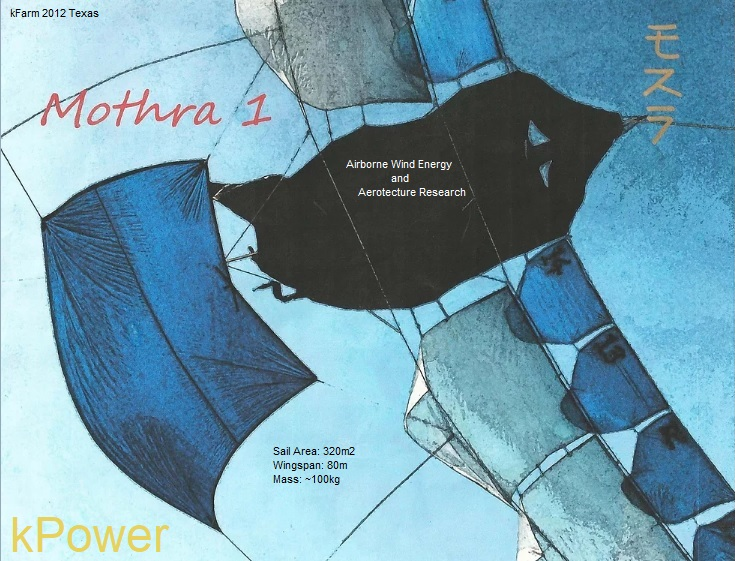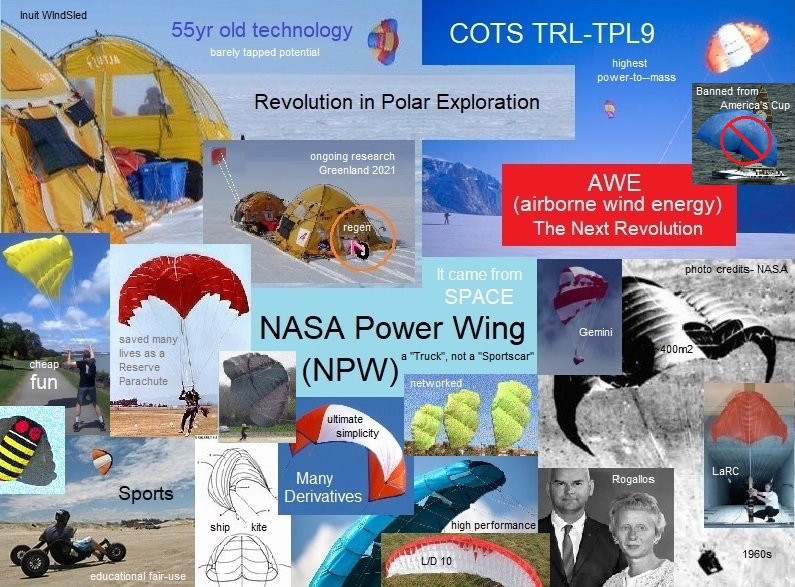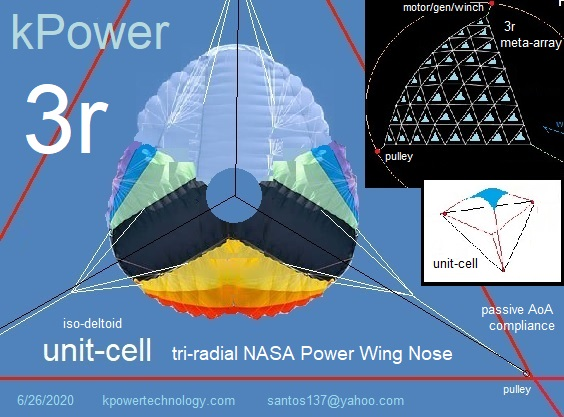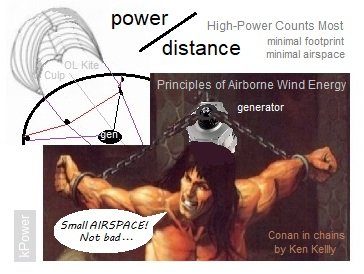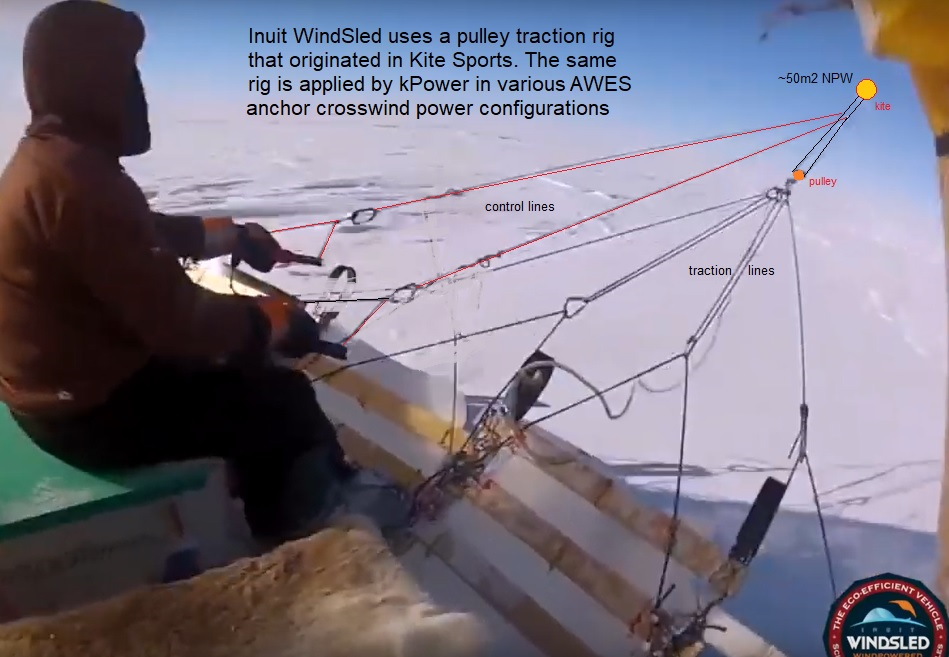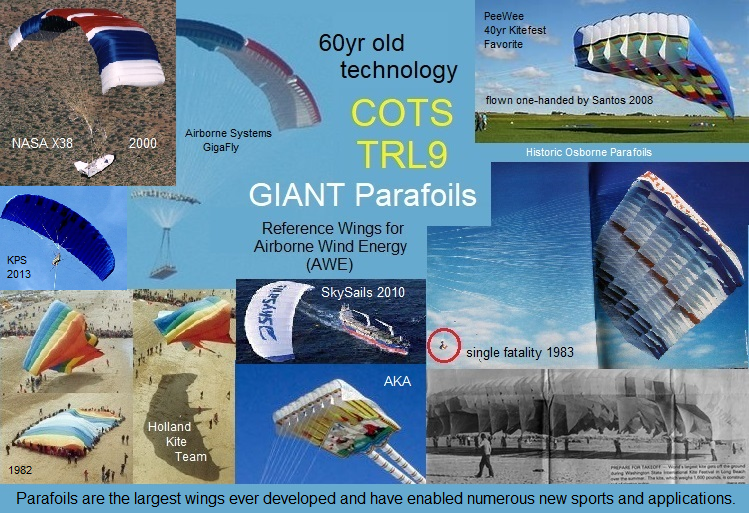Kited Single-Skin Canopy Wings SS
Also related: single-skin kites, mono-skin kites, kited sails, play sails, parachutes, drogues, primitive SS, mod-encrusted SS, hybrid SS, fabric SS, film SS, plate SS, ...
Contrast topic with rigid-framed single-skin wings, double-skinned wings
- 2e5
discussed, explored
- NASA
CR-66918 (pdf 302
pages)
FREE FLIGHT INVESTIGATION OF
LARGE ALL-FLEXIBLE PARAWINGS
AND PERFORMANCE COMPARISON WITH
SMALL PARAWINGS -
FINAL REPORT
BY
J. H. Moeller, E. M. Linhart, W. M. Gran, and L. T. Parson
Prepared under Contract No. NAS 1-7467 by
NORTHROP CORPORATION, VENTURA DIVISION
Newbury Park, California 91320
for
NATIONAL AERONAUTICS AND SPACE ADMINISTRATION
March 1970
- NASA CR 66879 June1969
- KiteShip flyer of 2003 re: "" Kite sails change the face and future of yacht racing at the 2003 America’s Cup, New Zealand".
Send
AWE notes and topic replies to editor@upperwindpower.com
Year 2021 single-skin kite momentum
Since the Rogallos, Barrish, and Dave Culp
developed amazing single skin power kites, they have held their own
next to Jalbert's parafoil. kPower got into SS wings via Culp, and came
to see them as the core future of AWE. Peter Lynn has come to the same
conclusion. In the last ten years, kite sports have increasingly
adopted SS wings at the expense of LEI and parafoil classes. We have
watched them become a craze since our pals, Reinhart Paelinck
(Flysurfer) and Luc d-Armand (Ozone) created the new generation of hot
SS kites.
Now SS is totally a "thing", as this Kiteboarder
2021 feature article shows. The text is cut off by a paywall, but we
can confidently guess the kite finished brilliantly, and also look at
the wing on its product page, derived from Reinhart's original
FlySurfer version.
- Vol. 17, No. 3: Single Skin Ascent | The Kiteboarder Magazine
- Flysurfer Peak 4 Single Skin Kite. (hardwaterkiter.com)
Refinement of Flysurfer Peak SS Power Kite
SS kites relentlessly improve fast. Hot SS power-kites were still a dream just ten years ago. I recall asking Pete Lynn in 2007 if he believed in them. We both did, in our imaginations.
Reinhart Paelinck's Flysurfer Peak SS lineage continues to introduce innovations and refinements, now in this best-selling snow-kite version-
Refinement of Flysurfer Peak SS Power Kite
http://www.adventurekiteboarding.com/flysurfer-peak4-single-skin-snowkite/
================
Dear
Dave and
Joe,
Oct. 25, 2020
I hope you are well in these weird times. The Peak indeed has unlocked an entire new class of "easy and safe" kiting, on snow, land and also water.
For your reference, I was in charge of the Peak 1 and 2; after that, Benni Boelli has taken over the Baton as kite designer at Flysurfer. Great talent !
Best regards,
Reinhart
================I hope you are well in these weird times. The Peak indeed has unlocked an entire new class of "easy and safe" kiting, on snow, land and also water.
For your reference, I was in charge of the Peak 1 and 2; after that, Benni Boelli has taken over the Baton as kite designer at Flysurfer. Great talent !
Best regards,
Reinhart
DaveS notes back:
Joe and I now count a dozen or more SS kite innovators. kPower is building NPWCs for AWE.
This cool new SS snow-kite came up today: a mix of KiteShip OL hotted-up and Born's vertical bar-
Note- Paraskiflex wings have a carbon rod LE, a good looking hybrid SS.
Paraskiflex
Re: Classic AWES Design Reference: 1970 Parawing NASA Report
Accepting that local unit-failures will happen, a key lesson of the NASA NPW work was the need for secondary load-paths to act as rip-stop barriers. Furthermore, Multi-r needs >3 legs and possibly a dozen or so for >99.999... megascale AWES availability-reliability. No single critical AWES failure-point is ever acceptable, which is why single-line AWES topologies with runaway hazard are a dead-end.
Our meta-kite will have the same property as NPW panels, that any local unit-kite failure will remain isolated and hardly affect overall performance. We have called identical lattice-ordered unit-kites "Kixels", after Pixels, for their addressable property, and individual kixel failure is just as non-critical as a bad-pixel in a display.
kPower's 2012 Mothra was a nice experience in Networked Kite Design. We never actually had a full kixel failure, but if we had, it would not have been critical.
Click image for large size:
Network Theory has applicable stability metrics, but the closest similarity-cases to ours are still to be located.
Multi-r Load-path Network Redundancy is analogous to a Metro Network Path Redundancy. This paper incidentally cites water suppply networks, Obviously biological networks like spiderwebs and vascular systems obey network stability principles-
Route Redundancy-Based Network Topology Measure of Metro Networks
Max,
There
are always "flight anomalies" in real free-flight, due to turbulence
and practical limits of active control stability. These factors worst
affect all the single-line topology rigid-wing composite AWES, not
NPWs. The WindSled Polar
expeditions, at least, can count on the crashworthiness of their SS
NPWs. NASA only considered free-flight of NPWs. Even so, the NPW is a
proven winner with cult-like status in power-kite circles.
We
have unit-kite stability mostly solved by many-connected unit-kite
topology. The NASA reports are full of useful-art like furling methods
for morphing, rip-stop panel layout, and self-friction-mode avoidance. We are very lucky to have all this old NASA SS unit-kite work to depend on. We
do not have NASA's challenge of high-speed deployment, nor issues of
unit-kite active control actuation saturation and complex-autonomy.
Our
bulk mega-scale meta-kite is also more stable by multi-connected
"staked-out" topology and lower dimensionless wind velocity. Iso-lattice
form-finding and operational research remains the big gap. We also need
to theoretically relate active control limits to the passive-restraint
alternative, to prove superiority of many-connected unit-kite
topological-stability in terms of shared numeric control-stability
derivatives.
Single-line single-kite AWES topologies face unhappy outcomes.
What fun our nicely solvable problems are!
What fun our nicely solvable problems are!
Re: Classic AWES Design Reference: 1970 Parawing NASA Report
Hello, Dave,
Thank you for finding this detailed report.
It shows that large-scale parawings are indeed possible.
However, the tests have not proven a stable operation of the giant
parawing. Most of the flights had "anomalies" : in overview table four, p.57 (77),
there is only four times "Good Test."
In my opinion, the "fractal" design is still superior over those
large-scale wings, even if having smaller effective wing area, as there
is graceful degradation.
Of course, all of my remarks may be largely out-dated, as the
development went on (they can drop tanks by now, don't they), and of
course this is the documentation of a very steep learning curve, so
proving a continuous stable operation may just still to be done.
Moreover, many of the damages have been be inflicted during the early
dropping phase, so my judgement may be unfair.
p.30:
"Structurally, the intermediate-scale parawings were consider-
ably more sophisticated than the small-scale wings. Design of the
large wings required that the canopies have adequate structure in
the direction of primary loads, where the load path direction
changed appreciably with geometry changes in the wing during the
deployment process. Also, these large wings with their asymmetric
planforms presented problems in controlling canopy fabric during
initial deployment. Indeed, parawing canopy structural problems
and deployment damage were the only major problems encountered
in the intermediate-scale test program. These problems manifested
themselves in the single keel parawing specimen early in the test
program. The single keel structural problems, cou~led with the
demonstrated higher gliding performance potential of the twin keel
parawing, were the bases for discontinuing further testing with
single keel parawings beyond the initial two tests. Later in the
test program similar structural problems were encountered with
the twin keel parawing specimen. A number of significant struc-
tural modifications were carried out on the twin keel wing to
overcome these problems. The structural modifications included
the addition of ten leading edge suspension lines, reinforcement
of certain critically loaded areas in the canopy, and the addition
of ripstop tape networks to the canopy. These structural modifi-
cations are described in detail in the section on INTERMEDIATE-
SCALE PARAWING TEST SPECIMENS."
ably more sophisticated than the small-scale wings. Design of the
large wings required that the canopies have adequate structure in
the direction of primary loads, where the load path direction
changed appreciably with geometry changes in the wing during the
deployment process. Also, these large wings with their asymmetric
planforms presented problems in controlling canopy fabric during
initial deployment. Indeed, parawing canopy structural problems
and deployment damage were the only major problems encountered
in the intermediate-scale test program. These problems manifested
themselves in the single keel parawing specimen early in the test
program. The single keel structural problems, cou~led with the
demonstrated higher gliding performance potential of the twin keel
parawing, were the bases for discontinuing further testing with
single keel parawings beyond the initial two tests. Later in the
test program similar structural problems were encountered with
the twin keel parawing specimen. A number of significant struc-
tural modifications were carried out on the twin keel wing to
overcome these problems. The structural modifications included
the addition of ten leading edge suspension lines, reinforcement
of certain critically loaded areas in the canopy, and the addition
of ripstop tape networks to the canopy. These structural modifi-
cations are described in detail in the section on INTERMEDIATE-
SCALE PARAWING TEST SPECIMENS."
NASA Power Wing- COTS TRL9 AWE WECS Reference Model
Latest kPower slide about the technological foundations of the "rag & string" Low-Complexity AWE paradigm. This is the NASA Power Wing story at a glance-
Click image for large size
Flysurfer Peak4 Single Skin Snowkite
SS
kites relentlessly improve fast. Hot SS power-kites were still a dream
just ten years ago. I recall asking Pete Lynn in 2007 if he believed in
them. We both did, in our imaginations.
Reinhart
Paelinck's Flysurfer Peak SS lineage continues to introduce innovations
and refinements, now in this best-selling snow-kite version-
- Flysurfer Peak4 Single Skin Snowkite at FlySurfer home site, details
- Flysurfer Peak4 Single Skin Snowkite at Adventure ....
- "The latest pure single skin is the NPWC Falken: http://2e5.com/kite/
npwc/falken/ The most underrated design is the Maeko http://2e5.com/kite/maeko/
a partially single skin design with good performance and easy construction."
- http://2e5.com/kite/npwc/foilnose3/ FoilNose
Classic AWES Design Reference: 1970 Parawing NASA Report
Covers
extensive NASA "parawing" testing at "Intermediate Scale" (~400m2) with
Theoretic Applicability to "Large Scale" (~1000m2).
Lots of test data and engineering details. 302 pages.
Nasa
Power Wings (NPWs) were intended to to recover returning spacecraft,
deploying from furled packed state, with high peak forces.
Solution
detail: Furling lines run through metal rings (hobbyist furling/trim
lines run in sewn sleeves, with limited restricted action).
Context:
by 1970 NASA had developed a basic power kite type to a high TRL (COTS)
and TPL (power-to-mass), scalable to 1000m2 and beyond.
Research
amounts to an Airborne Wind Energy Reference Design suited to compare
other Reference Designs in matrix-scoring, sims, and flyoff.
Competing
composite rigid-wing AWES airframes currently only survive a few hours,
are extremely expensive, and do not scale.
NPWs
are superior in every critical parameter. Crashworthy, they easily last
>2000hrs, and are cheap (low capital-cost, fast payback).
Lower specific power-by-wing-area, higher specific power-to-mass and power-to-airspace. A "truck", not a "sportscar."
Close
megascale Lattice Kite Network Unit-Cell similarity-case. kPower has
>10yrs NPW AWES-specific testing. Iso-radial version in development.
Large
habitable Windsleds powered by NPWs have revolutionized Polar
Exploration. There is a lot future in this space-age wing technology.
Flying big NPWs the Easy Way
NPWBill
wrote: "The old (NPW) gang that used to meet is no longer together and
I haven't heard from any of them for at least a decade. I'd love to see
it come back but I have my doubts and at 77 I can't fly those trucks
anymore"
Bill,
In
TX and WA we have learned to fly big power kites anchored in the
ground. Because there is no downwind give, the power is monstrous. The
pilot stays upwind of the anchor, so it is safe, but there is still an
amazing feeling of power. From there, we worked out how to power
generators and do mechanical work, but there is still a lot to learn.
Introducing
Eve of the Windsled folks who explore Polar regions with NPWs, and
Andrew, who has NPW expedition background too.
Airborne
Wind Energy (AWE) based on SS kites is the future. Nothing is cheaper
or more powerful by mass. Your NPW experience is very valuable. Do you
still make kites?
Cheers,
Dave
in Austin
------------
The
other NPW Bill, still trying to contact: 2e5.com
Bill Ola Rasmussen
His
NPWC is the "missing link" between NPW and KiteShip
OL.
kPower needs a research prototype made like a 3-way NPW that can fly in any direction:
kPower needs a research prototype made like a 3-way NPW that can fly in any direction:
Andrew McLean
Andrew's NPW page:
Powered Up – Build Your Own NASA Wing Kite : Andrew McLean | StraightChuter.com August 29, 2008 "Kiting is a quiver sport." [dgf]
============
Inuit WindSled: A Project for the sustainable Scientific Research of Polar regions
kPower kite energy airborne wind energy
NPWBill Just My Stuff
==============================
New SS Trainer Kites
SS products continue to gain traction- Flysurfer and Ozone are top brands; trainer kite classification proves these kites are not "too technical" for average use. Durability, power, and low-cost all come together-
FlySurfer SS Innovations- Looping Uphill, and Reefing System
Gets really interesting around 3:30 with looping-mode up a mountain and then showing the reefing system. The kitebag also doubles as a harness. The SS Power Kite continues to evolve very fast.
PEAK3
... Designer talk
Good review. I suspect the
doubters who did not like the Peak1 or 2 were merely unaccustomed to
radical SS feel and power, and then the 3 allowed them to openly fall
in
love-
Flysurfer Peak 3 Long Term Review.
"Single skin kites are taking over the kite world" (first reported here)
The third-party expert SS "taking over" 2019 quote in the subject line echoes taking-over predictions long made here about SS power kites, which came to AWE via Dave Culp as a fully formed analytic prediction 20 yrs ago, but leads even further back to 50yr old NASA Power Wing SS aerospace rocket-science. SS takeover predictions extend forward in AWE, with early rigid wings and even parafoils to be relentlessly overtaken. Its the SS Revolution as first announced here.
New SS "taking over" quotes occur in the page text and video at 1:30, with the Shaman reviewed, Gin a top Swiss developer and wingmaker, doing both PG and PK; converging kite-based sports also long discussed here (esp. Ozone case)-
https://www.youtube.com/watch?v=0jB8mUE8LFE
Thank you. Lift, Joe
